Kapfenberger SV are a team in the second Austrian division, who, in previous seasons, have been dangerously close to relegation consistently. However, an upturn in form since Abdulah Ibrakovic’s return to the dugout 14 months ago means they are well clear of the threat of going down and instead look to be breaking into the top half of the league for the first time in five years, ahead of the likes of RB Salzburg‘s youth side, FC Liefering.
From set-pieces, Kapfenberger scored seven out of their 23 league goals so far, making up 30% of the total amount. We will be looking into how set plays have played a part in turning their form around, with a particular focus on their corner kick routines.
In this tactical analysis, we will look into the tactics behind Kapfenberger’s offensive set-pieces, with an in-depth analysis of the advantages that stem from using different starting positions of the attacking unit. This set-piece analysis will also highlight how they have been able to sustain pressure from corner kicks in the second phase and the steps to take to increase efficiency in the future.
Deep Starting Positions
The high-value areas that most teams target from corners, leading to the easiest goalscoring opportunities, lie on the six-yard line boundary. Almost any headed effort on target from this short distance will likely hit the back of the net, with the goalkeeper having no time to react to the shot.
A common rule used by the greatest attackers in the sport is to arrive in space, to meet the ball on its path across the goal, rather than waiting in space for the ball to arrive to them. Arriving in space has three main benefits from corner kicks.
Firstly, a late arrival into space means that it is impossible for a man marker to recover the position, except if the attacker initially manages to gain separation from their marker. The penalty area consists of a game of moments. All that is needed to score a goal is one touch in a split-second moment. Players don’t need the space to control a ball or wind up a powerful strike. All that is required is a poke or jab at the ball, which can be missed in the blink of an eye.
As a result, players attacking the ball can sprint into the path of the ball without being set, as the overall execution of the shot does not have to be high to be successful. Think of it like getting on a train just as the doors shut, and it sets off from its platform. Once you have made it ahead of your defender, there is nothing the defender can do to disrupt you, and it’s too late for them to affect the outcome. Many teams use a mix of zonal and man-marking, but you can render the man-marker obsolete with the mastery of arriving in space.
The main theme of almost every Kapfenberger corner kick has been to start in a deep position, creating space between the man-markers and zonal defenders to isolate the two different groups, as shown in the example below. This way, players can clearly focus on first gaining separation from their markers, before attacking the zonal defenders.

The second and third main benefits of arriving in space go hand in hand. Attacking the ball at speed, rather than from a static position, means you gain a higher potential power in your body. The momentum with which a person travels means they can generate more power in both the jump, for the aerial duel, and the header at goal. Arriving in space brings players an advantage in the aerial duel against the static zonal defender, as well as the advantage during their effort on goal over the goalkeeper, who would be facing a shot coming at a higher velocity than if it was performed by a player from a static starting position.
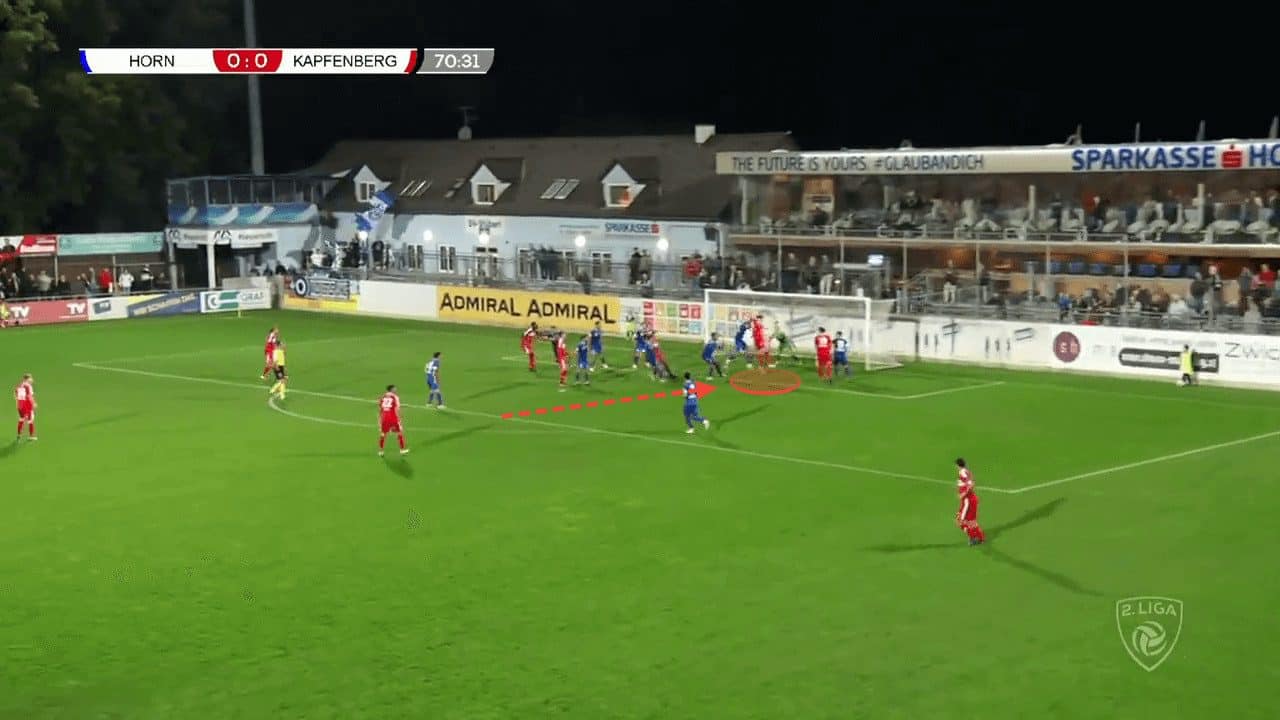
Something that Kapfenberger have recently done to vary their corner kicks has been to take the starting positions of the attacking unit to an extreme position. As seen in the image below, the Austrian side has recently moved the attacking unit to the opposite side of the penalty area, at the byline, taking Arsenal, the Premier League leaders, current setup from set plays to extreme lengths. No markers can track the ball’s flight from this position, and the attackers run simultaneously.
This is used to give each attacker a little help in creating separation from their respective marker. Each marker has to attempt to stay in the attackers’ path to prevent them from getting near the ball. When the defender turns to look at the ball as it is about to be crossed in, the attackers can move away from their markers and attempt to arrive in space by changing the arc of their run. If a defender doesn’t attempt to play the ball and solely focuses on blocking an attacker’s path, they are at risk of committing a foul.
Using a starting position in the defender’s blindside instantly gives the attacking unit the advantage in creating separation from their markers and making them less effective. However, the attackers need to time the moment of their runs while also relying on an accurate delivery into the box, which hasn’t always been the case.

Using Corner Kick Principles: Sustaining Pressure
A recent article highlighted one of the fundamental principles of corner kicks. In that, the importance of screens on both zonal defenders and the goalkeeper was made evident to help teams retain the ball following any mistakes during a corner kick routine, where chances could be created during the second phase through sustained pressure. Kapfenberger are a perfect example of how to use one element of the principle. The use of this element has been the reason why three of the six goals scored from corner kicks have come in the second phase rather than through the first contact, which was impossible following a poor delivery/movement from the attacking unit.
As you can see in the image below, a player makes a run to the near side of the six-yard box from deep to prevent the opposition from clearing the ball, following a poor corner kick that doesn’t reach waist height. When the nearest zonal defender attempts to clear the ball, the player highlighted arrives just in front, where a little flick allows the ball to pass the defender and become a loose ball inside the six-yard box. Although this doesn’t necessarily provide Kapfenberger with control of the ball, a poor delivery turns into a game of reactions, where both sides compete to be the first to make contact with the ball. From inside the six-yard box, any connection is highly likely to result in a goal.
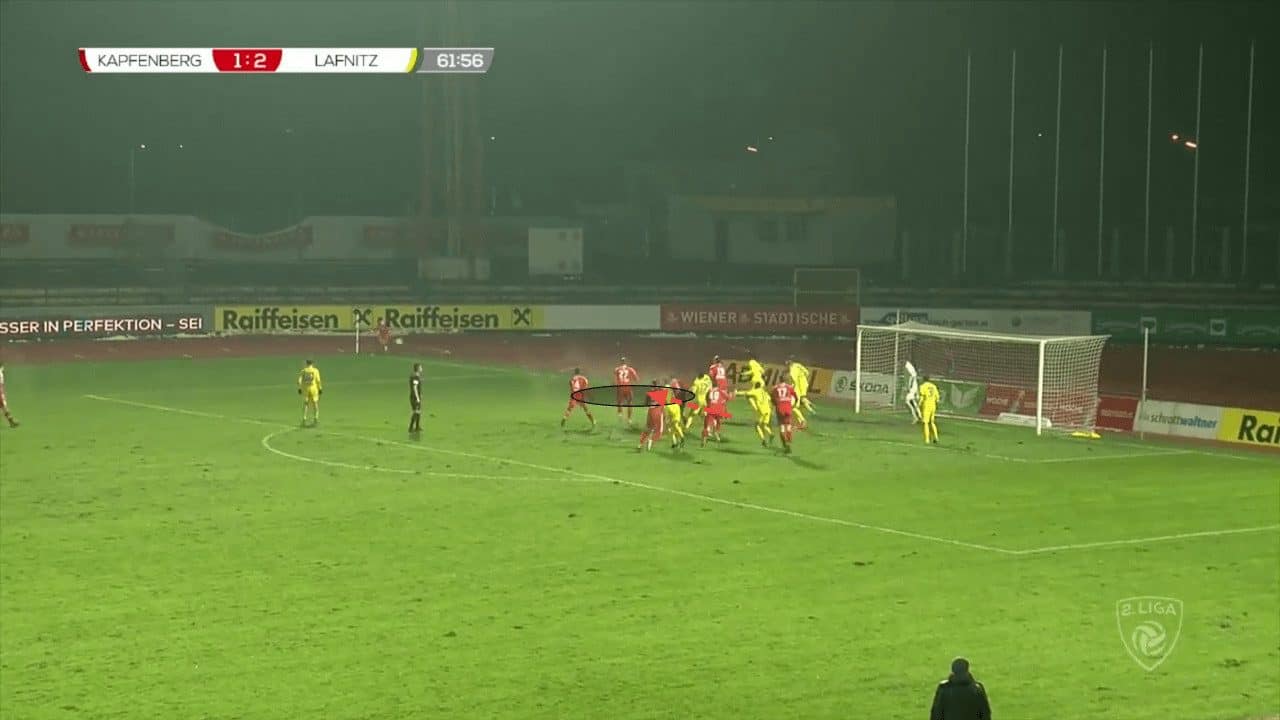
Below is another more explicit example of the player arriving ball-side of the defenders, making it impossible for the defensive side to clear the ball away from the box entirely. Rather than having distance between the defender and attacker, the player highlighted has positioned himself just in front of the green shirt to disrupt the clearance rather than attempt to play the ball. This is only in the cases where the ball looks to be too high for a Kapfenberger player, so rather than trying to play the ball, a screen is made on the zonal defenders.
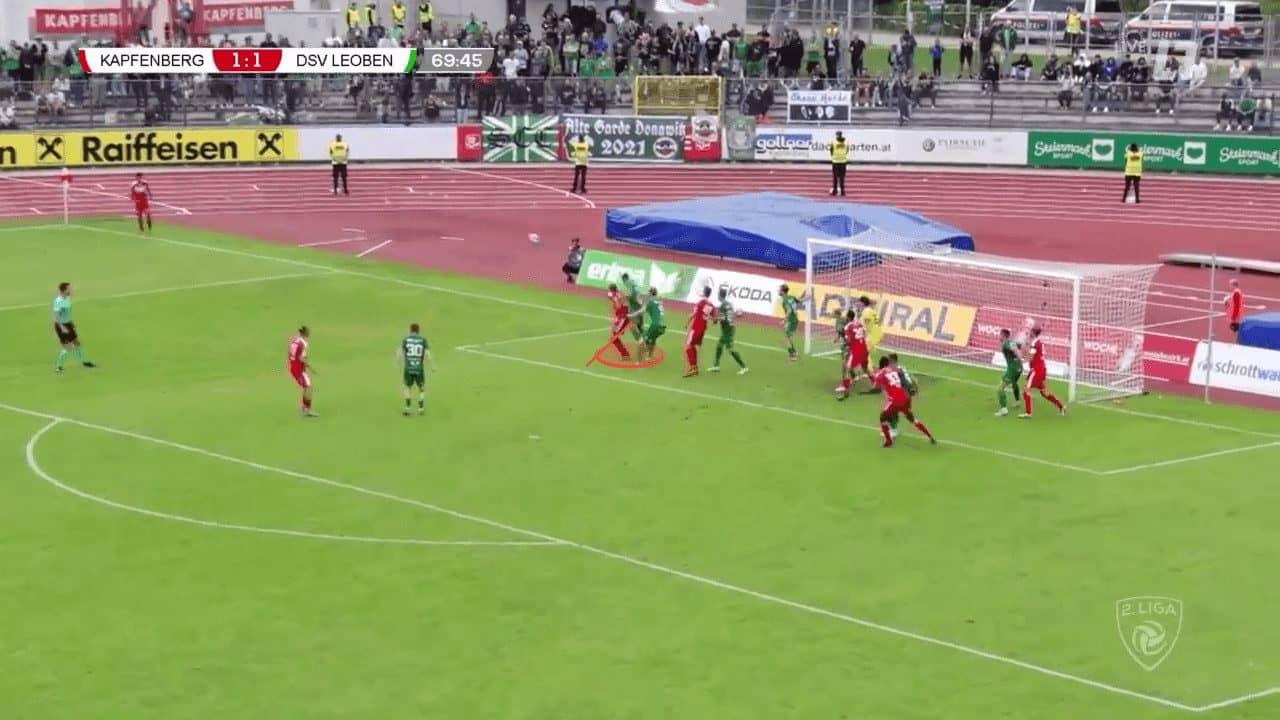
This means that whilst the opposition makes the first contact, it is weak and doesn’t clear the pressure. No defensive player is in a position to remove the ball from danger, but they can only put the ball into another possible dangerous position. In the instance below, the ball is cleared towards the penalty spot, although because Kapfenberger haven’t got a consistent presence on the edge of the box, no one is in a strong position to attack the ball.
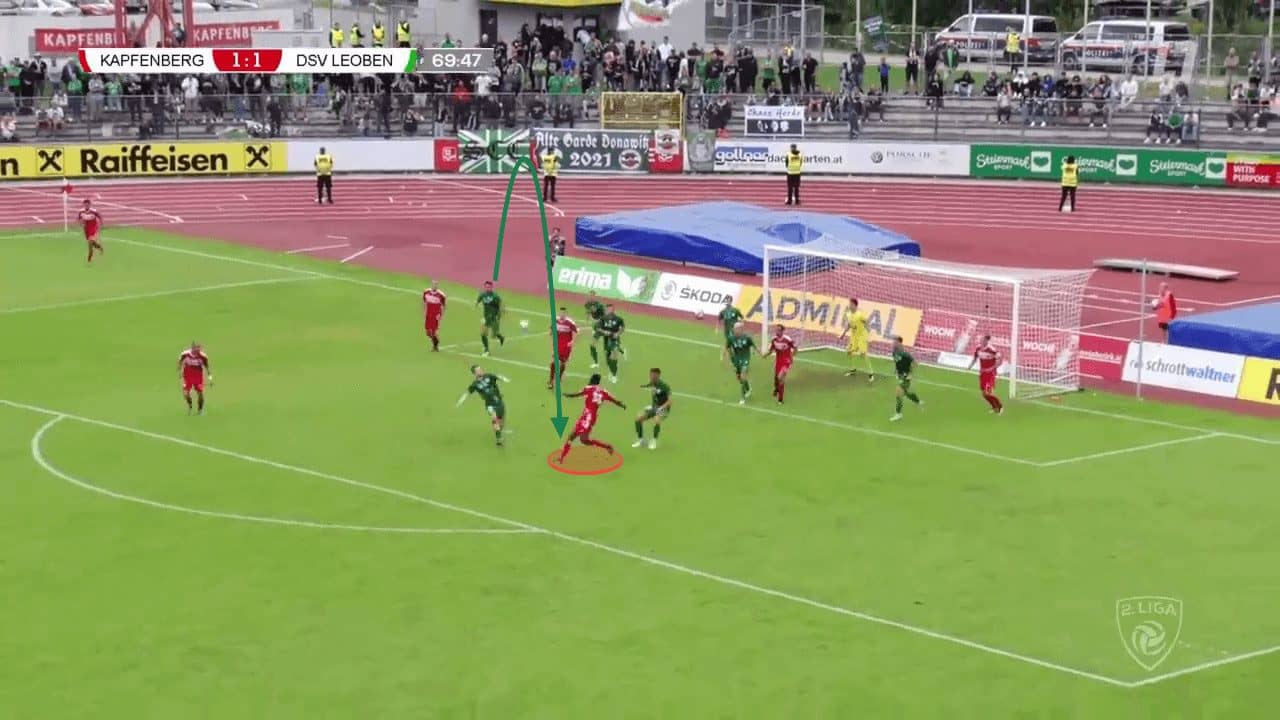
Whilst it is usually a safety measure, in the instances the corner perfectly flies at head height to the nearest player, where the zonal defenders haven’t attacked the ball, Kapfenberger can use this as a chance creation method. The inswinging corner kick means that only minimal contact is needed to redirect the ball into the path of the goal.
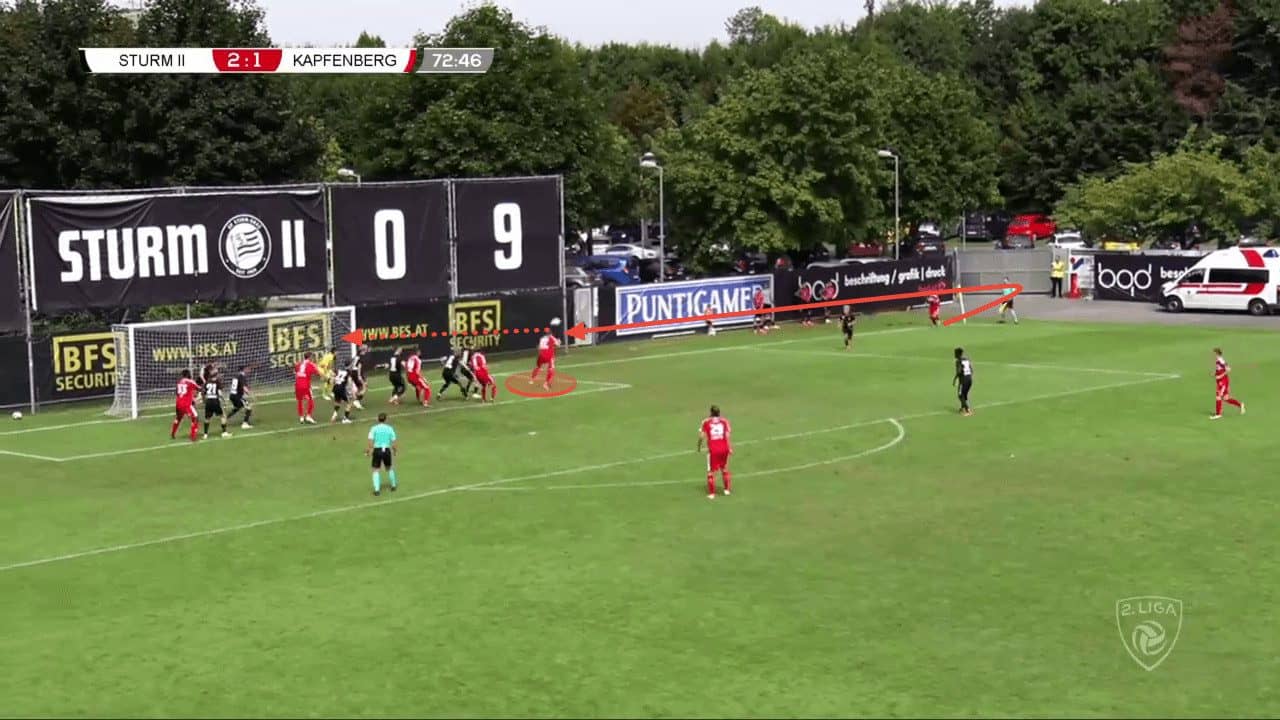
Possible Improvements
From around 80 corners, having six corner goals is a strong record. However, the problem, Kapfenberger, is the number of times they make the first contact. Being able to attack the ball with speed gives the attackers a better goal-conversion ratio from their headed efforts. The problem is that a red shirt doesn’t meet many crosses due to them failing to get separation from their marker. The recent variation in the starting positions of the attacking unit is an attempt to rectify this. However, there are several potential solutions.
Firstly, the use of screens within the attacking unit could help increase their efficiency. Rather than having five attackers all attempting to attack the ball, Kapfenberger could instead use just one or two of the players to provide a screen so that the other three or four have a much easier path to the six-yard box. While one player makes the run towards the six-yard box, a teammate can intercept the tracking movement made by the original attacker’s marker by blocking their path, providing the attacker with a clear path to the goal. The example below shows evidence of how this could be done, but it has not been attempted often enough this season.

Another issue Kapfenberger has faced is that the goalkeeper has claimed or cleared a portion of their corner kicks. The example below shows how much space a confident goalkeeper is capable of controlling, meaning that the goalkeeper will likely claim any ball inside the six-yard box within the posts. Placing one or two screens on the goalkeeper could be crucial to Kapfenberger, where they would instantly have much more room to cross the ball into, giving the attackers more freedom when making their runs. Currently, any run made inside the six-yard box will likely be cleared by the goalkeeper and can potentially lead to counterattacks.
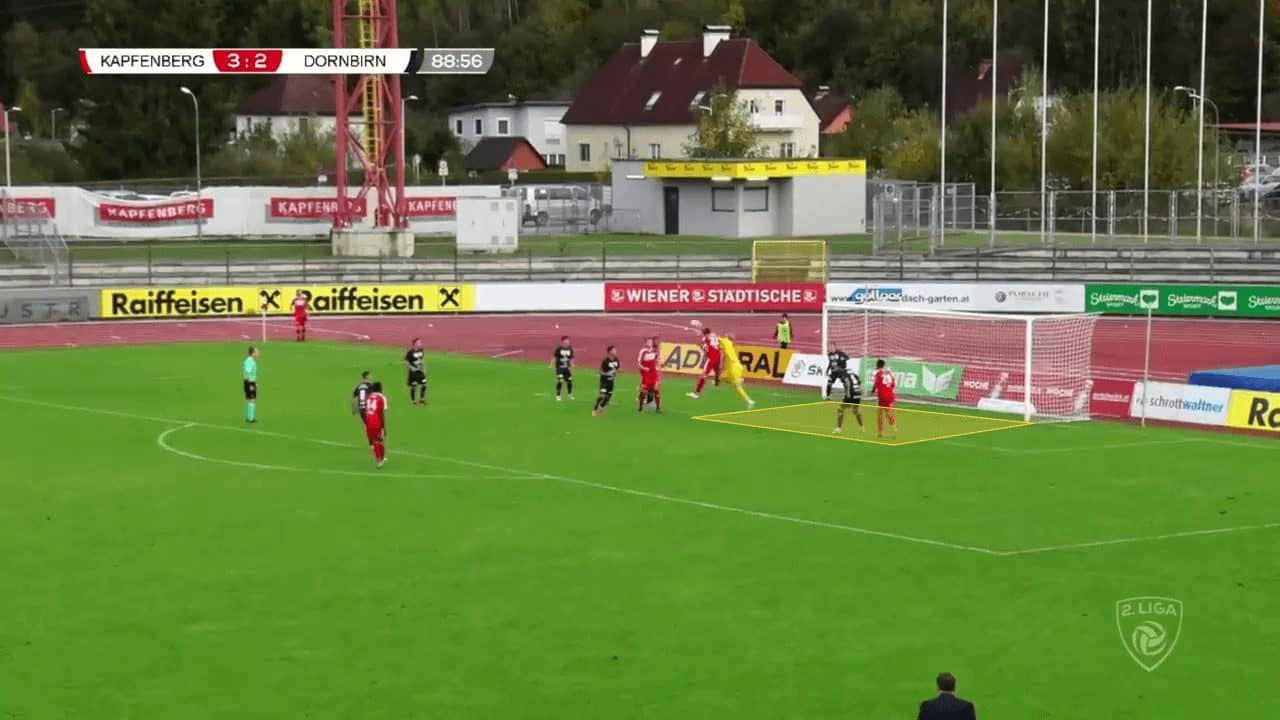
Summary
This set-piece analysis has shown how the second-tier Austrian side has been able to become a dangerous side from set plays. Through simple tweaks in the starting positions of attacking players, they can create numerous advantages for themselves against both man-marking and zonal setups and hybrids between the two.
They have also shown an excellent ability to sustain pressure on opponents following corner kicks. However, this tactical analysis has found they can exert even more control over their opponents through additions to their routines, in the forms of screens or blocks, and increasing the presence of players in the area around the edge of the box to have a higher chance of scoring in the second phase.






Comments